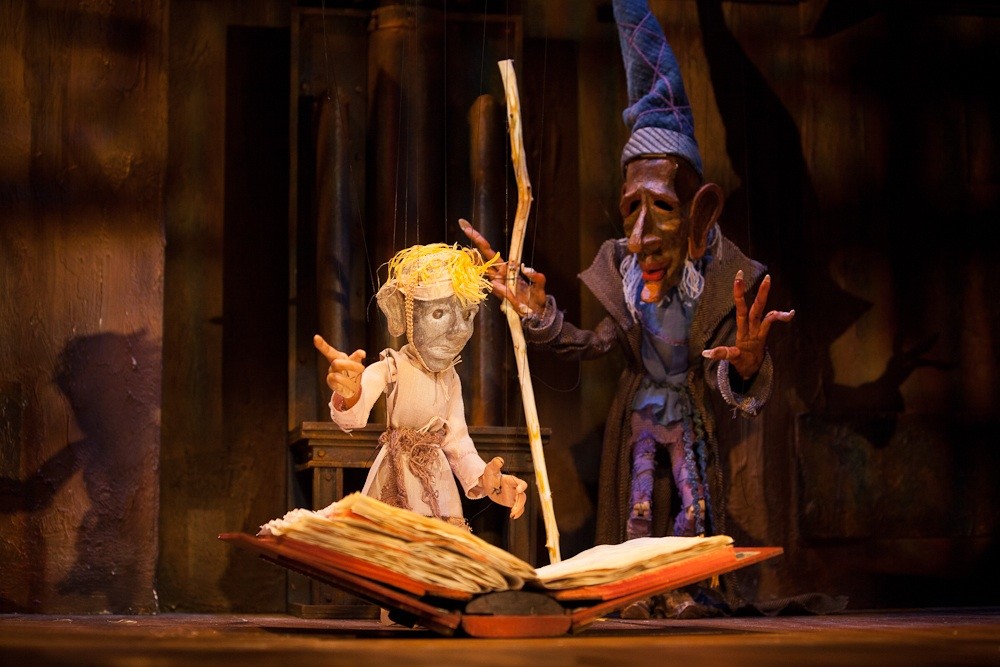What: âÄúThe SorcererâÄôs ApprenticeâÄù
Where: Open Eye Figure Theatre, 506 E. 24th St.
When: Feb. 10-March 4
Cost: $12 for students
Most people know âÄúThe SorcererâÄôs ApprenticeâÄù from DisneyâÄôs âÄúFantasia.âÄù The nine-minute short is adapted from the Johann Wolfgang von Goethe poem and set to the Paul Dukas piece of the same name. It finds apprentice Mickey Mouse stealing his masterâÄôs wand and enchanting a broom, which multiplies and threatens to cause a flood before the sorcerer arrives and saves the day.
ItâÄôs a familiar tale, but now Michael Sommers and his Open Eye Figure Theatre are adapting it into a feature-length puppet show in an attempt to expand the audienceâÄôs perspective on not only the story, but also marionette theater.
Sommers, who wrote, directed and designed the show, is a veteran of puppetry and image-based theater. ItâÄôs his first all-puppet production since 2007âÄôs âÄúA Prelude to Faust.âÄù Sommers said he uses puppets because they allow him to create a world that would not be possible with actors.
âÄúYou can flood the entire world. You can transform scale; the sorcerer becomes gigantic. You can float and fly across the space. You can ride on a stick. You can be half cat and half rat,âÄù he said.
Justin Spooner, one of the puppeteers in âÄúThe SorcererâÄôs Apprentice,âÄù directed a show entitled âÄúWaterboxâÄù for artist collective 1419 last fall. The show used inventive underwater puppetry to create abstract images set to music.
Sommers says that while this type of high-concept production was tempting, he ultimately kept âÄúThe SorcererâÄôs ApprenticeâÄù simple in order to show off what could be done using the tried-and-true techniques of marionette theater.
âÄúItâÄôs all about the human hand doing something. Take the flood for example,âÄù he said. âÄúWeâÄôre looking at traditional ways. How do you do water? We want to create these stage pictures and events in a way thatâÄôs interesting, but everyone knows how theyâÄôre done. ItâÄôs tried and true. You raise a cloth up and it says âÄòwater.âÄôâÄù*****
Despite its traditional trappings, âÄúThe SorcererâÄôs ApprenticeâÄù is a weighty and sweeping production. It is lit like an opera and set to original music by Eric Jensen. Trombone, viola, bass clarinet and xylophone underscore almost the entire show. The music is jaunty but also has deep threads of melancholy, Sommers said.
GoetheâÄôs original poem is only about 100 lines, so to adapt âÄúThe SorcererâÄôs ApprenticeâÄù into a 50-minute chamber piece, Sommers made some changes. He even added a new character, Crat.
Crat, a half-cat, half-rat servant to the sorcerer, acts as a foil to the apprentice in the story and serves as a catalyst for the changes Sommers has made to the end of the show.
In the original poem and in âÄúFantasia,âÄù the sorcerer swoops in and stops the flood before the apprentice perishes. SommersâÄô version delays this deus ex machina, allowing things to get even worse for the apprentice and Crat. This raises the stakes and more fully explores the apprenticeâÄôs role as the heir to the sorcererâÄôs power.
âÄúThe show is about the accumulation of knowledge. What do we need to know to become an apprentice and what do we need to know to become a master?” Sommers said.
With âÄúThe SorcererâÄôs Apprentice,âÄù Sommers hopes to expand the audienceâÄôs appreciation for both a story and a medium that most people are only vaguely familiar with.
âÄúItâÄôs interesting to me how the form can surprise people. ItâÄôs telling the same story but in a slightly different way,âÄù Sommers said. âÄúIt really hearkens to the long tradition of marionette theater.âÄù














